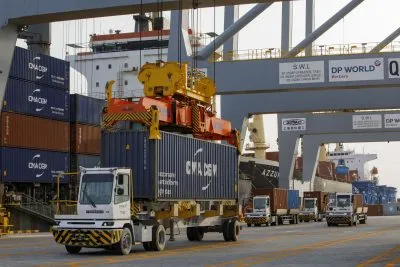The economic uncertainty in the wake of the Covid-19 pandemic places a huge load on economists to formulate effective recovery and resilience strategies, and this is all the more the case in sub-Saharan Africa.
According to the World Bank’s recent biannual Africa’s Pulse report, the pandemic has taken its toll on economic activity in sub-Saharan Africa, putting a decade of hard-won economic progress at risk.
Depending on the success of measures taken to mitigate the pandemic’s effects, it is estimated that economic growth in sub-Saharan Africa dropped from 2.4% in 2019 to between -2.1% and -5.1% in 2020. This could claw back some of the major strides that Africa has made in its participation in trade and value chains as well as result in a reduction of foreign financing inflows.
Africa’s international trade relationships and transactions are vital and have showcased significant growth over the last two decades. According to a recent UNCTAD report, in the period 2015-17 total trade from Africa to the rest of the world averaged $760bn in current prices. Similarly, the share of exports from Africa to the rest of the world represented 80-90% of Africa’s total trade transactions between 2000 and 2017.
However, a decline in Africa’s international trade activity could have a silver lining. There is growing consensus among economic planners of a need to shift the mindset on intra-African trade and view it as a key driver of economic growth in the post Covid-19 era. Intra-African trade provides a compelling opportunity to move away from significant reliance on extractive exports.
However, oil, minerals and agricultural exports are subject to price volatility and require less labour, thereby limiting employment opportunities for a continent with a young population.
Conversely, according to the UN Economic Commission for Africa (ECA), when African countries trade with each other, they exchange more manufactured and processed goods, have more knowledge transfer, and create more value. In addition, greater value addition or sophistication increases the value of the exports and therefore productivity. Africa’s growth is fuelled by small to medium-sized enterprises (SMEs).
SMEs possess the extraordinary ability to tap regional African markets, grow exponentially and create jobs, while also accounting for 80% of the region’s trade, according to the Africa Trade Policy Centre (ATPC).
Reducing barriers
The opportunity for intra-African trade is best viewed with a “glass half-full” approach with an equally pragmatic view of the challenges that lie ahead.
Let’s start with the barriers to trade on the continent. Barriers such as high tariffs and poor supply chain infrastructure raise trade costs, erode the competitiveness of goods and services, inhibit exports and generally stifle economic growth. Recent studies conducted by the World Bank indicate that 75% of the delays in the movements of goods are from trade facilitation and that 25% are attributed to infrastructure.
Proof exists that these barriers can be reduced. Poor infrastructure causes congestions, delay and ultimately high transportation costs. African countries have begun investing in physical infrastructure at key ports, introducing One-Stop Border Posts (OSBPs) whilst doubling down on soft infrastructure such as integrated border management systems as well as mobility of human resources.
The advantage of OSBPs is that they eliminate the need for vehicles, travellers and goods to stop twice to undertake duplicated border-crossing formalities. According to the African Union’s Programme for Infrastructure Development in Africa (PIDA), African regional economic communities have identified approximately 76 border posts for implementation.
Addressing the infrastructural challenges will lead to a reduction in key trade bottlenecks, faster movement of goods through key links and nodes, and ultimately lower transport costs.
Encouraging signs
The crystal ball shows encouraging signs on Africa’s trade facilitation front. Two years ago, African countries inked a landmark trade agreement, the African Continental Free Trade Agreement (AfCFTA), which commits countries to remove tariffs on 90% of goods, progressively liberalise trade in services, and address a host of other non-tariff issues including import quotas.
The agreement will certainly deepen trade, boost economies, create jobs and achieve the elusive market integration objectives. The 54 signatures created a single African market of over a billion consumers with a total GDP of over $3 trillion, making Africa the largest free trade area in the world. Globally, trade agreements, like human relations, carry hopes and suspicions. Pulling off AfCFTA was therefore a great feat by African countries from a trade negotiations perspective.
AfCTA’s scope exceeded traditional trade agreements and covers intellectual property rights, e-commerce and competition policies which have diminished trade and heightened protectionism. It provides an opportunity for African countries to improve diversification in exports and trade.
This is expected to significantly benefit agricultural products. African countries spend over $80bn in food imports. According to the ECA, AfCTA is expected to expand access to markets at a regional and international level, thus generating state revenue and increasing farmer income, resulting in the provision of reserves for investing purposes especially in modernising the agricultural sector through processing and mechanisation.
AfCTA is key to paving the road to intra-African trade but the road remains bumpy, for now. Apart from promoting intra-African trade, AfCFTA’s litmus test will showcase how quickly African countries can fast-track export diversification and product sophistication thus making trade more inclusive. Domestic policymakers need to demonstrate the commitment to industrialisation and manufacturing.
A unique catalyst for intra-African trade is the empowerment and inclusion of women in cross-border trade. According to the UN Women factsheet Unleashing the Potential of Women Informal Cross Border Traders to Transform Intra-African Trade, informal cross-border trade has become an integral part of trade flows for the East African Community and Southern African Development Community countries.
The report states that over 70% of the cross-border traders are women. Meanwhile, in West and Central Africa, women informal cross-border traders “employ 1.2 people in their home businesses; support on average 3.2 children as well as 3.1 dependants who were not children or spouses”. Interventions targeted at intra-African exports and imports therefore have a huge potential to drive development, inclusion and poverty reduction.
The consequences of a Covid-19-driven recession should be the perfect excuse for African governments to hasten the mainstreaming of intra-African trade in their respective national trade and development strategies. The impact will be felt for years to come if policymakers fail to address this now.
Sarmad Lone is regional head of corporate, commercial and institutional banking – Africa & Middle East at Standard Chartered.
Want to continue reading? Subscribe today.
You've read all your free articles for this month! Subscribe now to enjoy full access to our content.
Digital Monthly
£8.00 / month
Receive full unlimited access to our articles, opinions, podcasts and more.
Digital Yearly
£70.00 / year
Our best value offer - save £26 and gain access to all of our digital content for an entire year!

 Sign in with Google
Sign in with Google 






